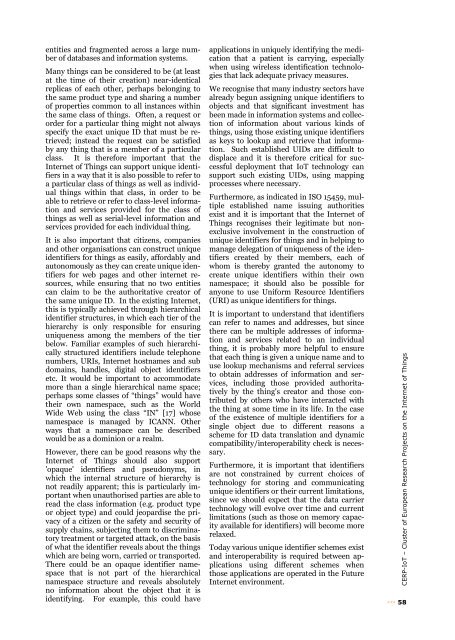Vision and Challenges for Realising the Internet of Things
Vision and Challenges for Realising the Internet of Things
Vision and Challenges for Realising the Internet of Things
Create successful ePaper yourself
Turn your PDF publications into a flip-book with our unique Google optimized e-Paper software.
entities <strong>and</strong> fragmented across a large number<br />
<strong>of</strong> databases <strong>and</strong> in<strong>for</strong>mation systems.<br />
Many things can be considered to be (at least<br />
at <strong>the</strong> time <strong>of</strong> <strong>the</strong>ir creation) near-identical<br />
replicas <strong>of</strong> each o<strong>the</strong>r, perhaps belonging to<br />
<strong>the</strong> same product type <strong>and</strong> sharing a number<br />
<strong>of</strong> properties common to all instances within<br />
<strong>the</strong> same class <strong>of</strong> things. Often, a request or<br />
order <strong>for</strong> a particular thing might not always<br />
specify <strong>the</strong> exact unique ID that must be retrieved;<br />
instead <strong>the</strong> request can be satisfied<br />
by any thing that is a member <strong>of</strong> a particular<br />
class. It is <strong>the</strong>re<strong>for</strong>e important that <strong>the</strong><br />
<strong>Internet</strong> <strong>of</strong> <strong>Things</strong> can support unique identifiers<br />
in a way that it is also possible to refer to<br />
a particular class <strong>of</strong> things as well as individual<br />
things within that class, in order to be<br />
able to retrieve or refer to class-level in<strong>for</strong>mation<br />
<strong>and</strong> services provided <strong>for</strong> <strong>the</strong> class <strong>of</strong><br />
things as well as serial-level in<strong>for</strong>mation <strong>and</strong><br />
services provided <strong>for</strong> each individual thing.<br />
It is also important that citizens, companies<br />
<strong>and</strong> o<strong>the</strong>r organisations can construct unique<br />
identifiers <strong>for</strong> things as easily, af<strong>for</strong>dably <strong>and</strong><br />
autonomously as <strong>the</strong>y can create unique identifiers<br />
<strong>for</strong> web pages <strong>and</strong> o<strong>the</strong>r internet resources,<br />
while ensuring that no two entities<br />
can claim to be <strong>the</strong> authoritative creator <strong>of</strong><br />
<strong>the</strong> same unique ID. In <strong>the</strong> existing <strong>Internet</strong>,<br />
this is typically achieved through hierarchical<br />
identifier structures, in which each tier <strong>of</strong> <strong>the</strong><br />
hierarchy is only responsible <strong>for</strong> ensuring<br />
uniqueness among <strong>the</strong> members <strong>of</strong> <strong>the</strong> tier<br />
below. Familiar examples <strong>of</strong> such hierarchically<br />
structured identifiers include telephone<br />
numbers, URIs, <strong>Internet</strong> hostnames <strong>and</strong> sub<br />
domains, h<strong>and</strong>les, digital object identifiers<br />
etc. It would be important to accommodate<br />
more than a single hierarchical name space;<br />
perhaps some classes <strong>of</strong> “things” would have<br />
<strong>the</strong>ir own namespace, such as <strong>the</strong> World<br />
Wide Web using <strong>the</strong> class “IN” [17] whose<br />
namespace is managed by ICANN. O<strong>the</strong>r<br />
ways that a namespace can be described<br />
would be as a dominion or a realm.<br />
However, <strong>the</strong>re can be good reasons why <strong>the</strong><br />
<strong>Internet</strong> <strong>of</strong> <strong>Things</strong> should also support<br />
'opaque' identifiers <strong>and</strong> pseudonyms, in<br />
which <strong>the</strong> internal structure <strong>of</strong> hierarchy is<br />
not readily apparent; this is particularly important<br />
when unauthorised parties are able to<br />
read <strong>the</strong> class in<strong>for</strong>mation (e.g. product type<br />
or object type) <strong>and</strong> could jeopardise <strong>the</strong> privacy<br />
<strong>of</strong> a citizen or <strong>the</strong> safety <strong>and</strong> security <strong>of</strong><br />
supply chains, subjecting <strong>the</strong>m to discriminatory<br />
treatment or targeted attack, on <strong>the</strong> basis<br />
<strong>of</strong> what <strong>the</strong> identifier reveals about <strong>the</strong> things<br />
which are being worn, carried or transported.<br />
There could be an opaque identifier namespace<br />
that is not part <strong>of</strong> <strong>the</strong> hierarchical<br />
namespace structure <strong>and</strong> reveals absolutely<br />
no in<strong>for</strong>mation about <strong>the</strong> object that it is<br />
identifying. For example, this could have<br />
applications in uniquely identifying <strong>the</strong> medication<br />
that a patient is carrying, especially<br />
when using wireless identification technologies<br />
that lack adequate privacy measures.<br />
We recognise that many industry sectors have<br />
already begun assigning unique identifiers to<br />
objects <strong>and</strong> that significant investment has<br />
been made in in<strong>for</strong>mation systems <strong>and</strong> collection<br />
<strong>of</strong> in<strong>for</strong>mation about various kinds <strong>of</strong><br />
things, using those existing unique identifiers<br />
as keys to lookup <strong>and</strong> retrieve that in<strong>for</strong>mation.<br />
Such established UIDs are difficult to<br />
displace <strong>and</strong> it is <strong>the</strong>re<strong>for</strong>e critical <strong>for</strong> successful<br />
deployment that IoT technology can<br />
support such existing UIDs, using mapping<br />
processes where necessary.<br />
Fur<strong>the</strong>rmore, as indicated in ISO 15459, multiple<br />
established name issuing authorities<br />
exist <strong>and</strong> it is important that <strong>the</strong> <strong>Internet</strong> <strong>of</strong><br />
<strong>Things</strong> recognises <strong>the</strong>ir legitimate but nonexclusive<br />
involvement in <strong>the</strong> construction <strong>of</strong><br />
unique identifiers <strong>for</strong> things <strong>and</strong> in helping to<br />
manage delegation <strong>of</strong> uniqueness <strong>of</strong> <strong>the</strong> identifiers<br />
created by <strong>the</strong>ir members, each <strong>of</strong><br />
whom is <strong>the</strong>reby granted <strong>the</strong> autonomy to<br />
create unique identifiers within <strong>the</strong>ir own<br />
namespace; it should also be possible <strong>for</strong><br />
anyone to use Uni<strong>for</strong>m Resource Identifiers<br />
(URI) as unique identifiers <strong>for</strong> things.<br />
It is important to underst<strong>and</strong> that identifiers<br />
can refer to names <strong>and</strong> addresses, but since<br />
<strong>the</strong>re can be multiple addresses <strong>of</strong> in<strong>for</strong>mation<br />
<strong>and</strong> services related to an individual<br />
thing, it is probably more helpful to ensure<br />
that each thing is given a unique name <strong>and</strong> to<br />
use lookup mechanisms <strong>and</strong> referral services<br />
to obtain addresses <strong>of</strong> in<strong>for</strong>mation <strong>and</strong> services,<br />
including those provided authoritatively<br />
by <strong>the</strong> thing's creator <strong>and</strong> those contributed<br />
by o<strong>the</strong>rs who have interacted with<br />
<strong>the</strong> thing at some time in its life. In <strong>the</strong> case<br />
<strong>of</strong> <strong>the</strong> existence <strong>of</strong> multiple identifiers <strong>for</strong> a<br />
single object due to different reasons a<br />
scheme <strong>for</strong> ID data translation <strong>and</strong> dynamic<br />
compatibility/interoperability check is necessary.<br />
Fur<strong>the</strong>rmore, it is important that identifiers<br />
are not constrained by current choices <strong>of</strong><br />
technology <strong>for</strong> storing <strong>and</strong> communicating<br />
unique identifiers or <strong>the</strong>ir current limitations,<br />
since we should expect that <strong>the</strong> data carrier<br />
technology will evolve over time <strong>and</strong> current<br />
limitations (such as those on memory capacity<br />
available <strong>for</strong> identifiers) will become more<br />
relaxed.<br />
Today various unique identifier schemes exist<br />
<strong>and</strong> interoperability is required between applications<br />
using different schemes when<br />
those applications are operated in <strong>the</strong> Future<br />
<strong>Internet</strong> environment.<br />
CERP-IoT – Cluster <strong>of</strong> European Research Projects on <strong>the</strong> <strong>Internet</strong> <strong>of</strong> <strong>Things</strong><br />
58
















